Affiliate disclosure: This post may contain affiliate links. Please see our Privacy Policy.
Elderflower wine is a delightfully tasty way to use elderflowers, and it makes for sweet sipping all year long.
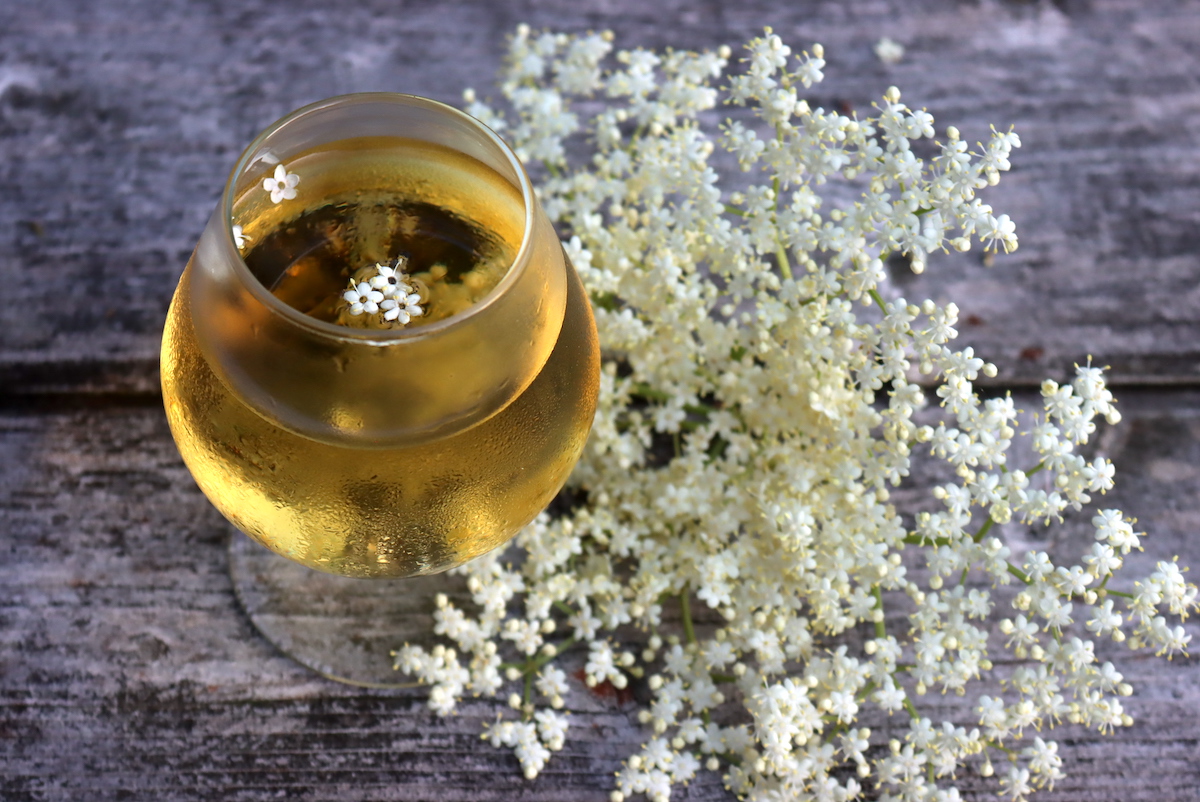
Elderflowers are a welcome sight each summer, and their tiny white blossoms brighten the landscape for just a few brief weeks. They’re incredibly fragrant and beautiful, but they’re also tasty edible flowers that can be used in all manner of elderflower recipes.
They’re incredibly popular as a flavoring in Europe, especially Germany and Austria, where elderflower syrup can be found in any grocery store.
Since elderflowers are a natural source of wild yeast, they’re often made into simple elderflower sodas (also known as elderflower champagne). It’s not really a “champagne” as most people envision it, but a simple yeasted soda that’s made with champagne yeast and only fermented a few days. It’s very mildly alcoholic, only about 1-2%, but it’s very fizzy…thus the name champagne.
Since it’s a “soda,” it won’t store, as there’s plenty of sugar in there still, and left for any period of time, it’ll continue to ferment and become wine.
So why not just go all the way and make elderflower wine instead? It’s absolutely delicious and incorporates the fresh flavor of elderflowers in a homemade wine that will keep on your shelf for many years. You can sip these fragrant summer blooms in the depth of winter, rather than just making a quick summertime soda.
If you use honey instead of sugar as the sweetener, it turns into elderflower mead, which is even tastier, in my opinion.
This recipe for elderflower wine and mead follows my basic recipe for flower wines and meads, and if you’re new to winemaking, it can help if you read that article first. It’s a bit longer, and covers more of the basic steps to help you understand what’s happening at each stage of the process. It also goes over the ingredients and equipment in more detail.
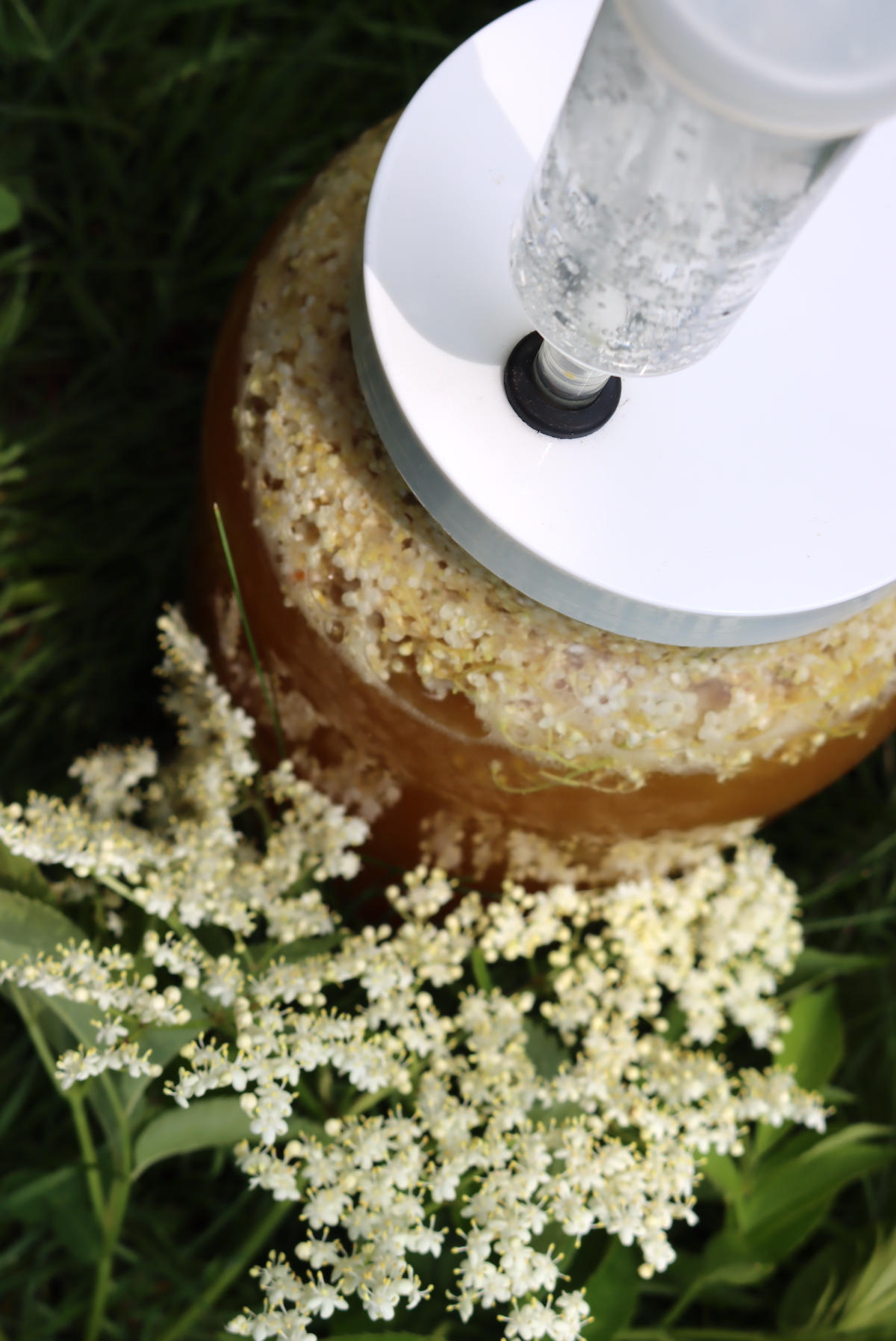
Ingredients for Elderflower Wine
The ingredients for making elderflower wine (or mead) are very similar to any floral or herbal wine/mead. Flowers or herbs are used for flavoring, but the majority of the fermentable sugar comes from honey or plain sugar. Since the flowers or herbs aren’t acidic or tannic like fruits, you’ll also need to add lemon juice (or acid blend) and tannin powder (or black tea).
Lastly, you’ll need a bit of yeast nutrients to feed the yeasts, as they can’t live on sugar alone, and they need the micro-nutrients that grapes would provide if you were making grape wine.
If you’re harvesting elderflowers in the wild, be sure to read this elderflower identification guide and avoid look-alikes. (Of course, you can always harvest them from your own garden or buy dried flowers, and then it’s a little easier to be certain what you have.)
The basic recipe for a herbal or flower wine is as follows:
- 1 quart stemmed elderflowers (from about 1 1/2 to 2 gallons flower sprays)
- 5 to 6 cups sugar (or 3 lbs honey)
- 6 cups white grape juice (for wine only, skip if using honey)
- 1/4 cup lemon juice
- 1 tsp yeast nutrient
- 1/4 tsp wine tannin
- 1 packet wine yeast
This same basic recipe is used to make lilac wine with fresh lilac flowers in the spring, and lemon balm mead with our abundant summer crops of lemon balm.
For the elderflowers, you’ll want about a quart of stemmed elderflowers, which is quite a bit on the stem. Estimate that you’ll need about a 1 1/2 to 2 gallons of blossom sprays.
You can use dried elderflowers as well. If using dried, you’ll only need 2 cups flowers as they shrink when dehydrated.
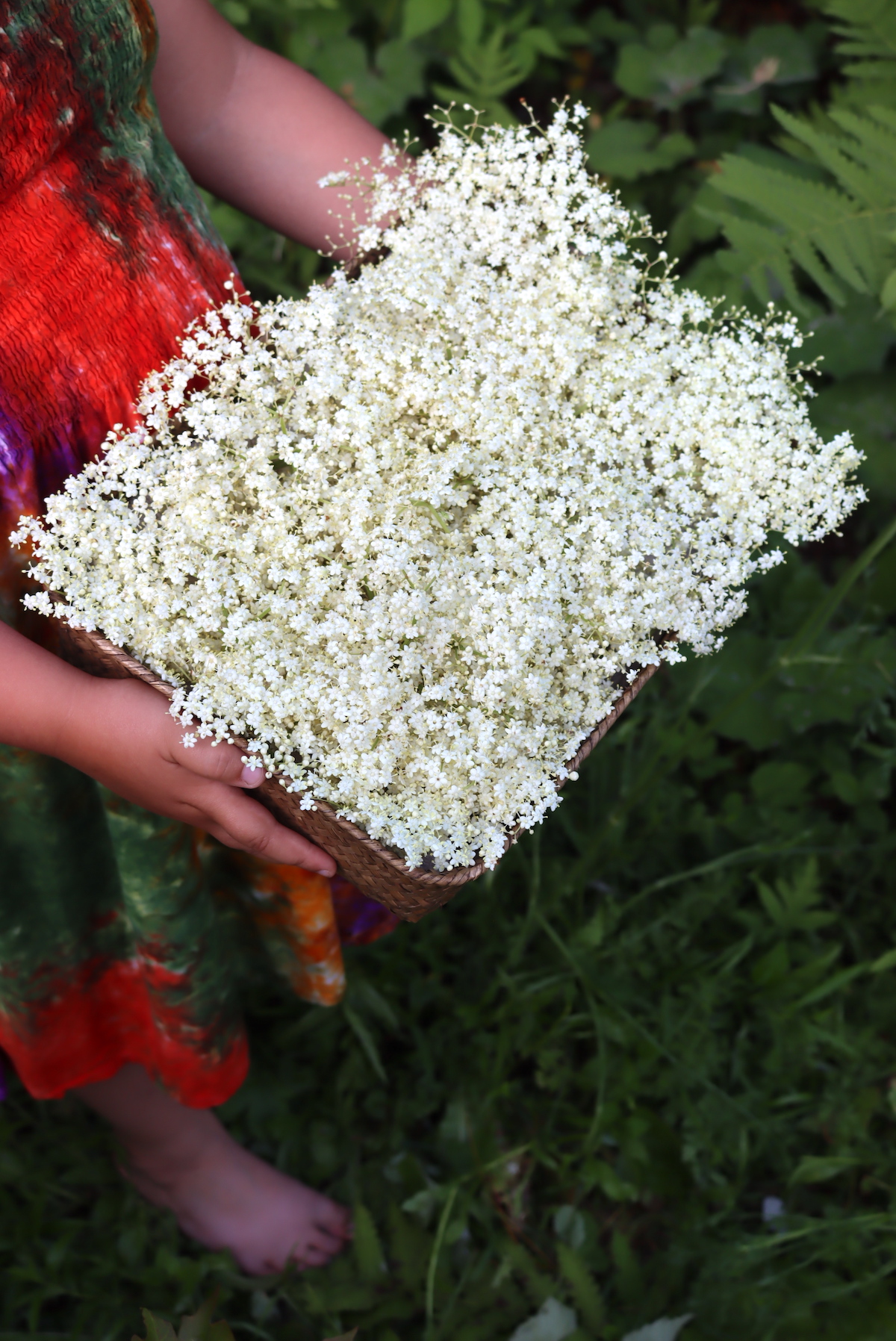
The sugar or honey may seem like a lot, but that’s almost all converted to alcohol by the yeast in the winemaking process. You need that much to ensure that there’s residual sweetness in the finished wine, as a completely dry elderflower wine is basically flavorless.
Floral wines do best when they finish a bit on the sweet side.
If you use plain sugar, you’ll have plain wine. It will be light-bodied, as floral wines tend to be. With honey, you’ll get what’s known as mead, and it’ll have more flavor complexity from the honey…and also a good bit more body.
Adding white grape juice adds body to sugar wines, and I highly recommend it if making a wine with sugar. It’s not necessary if using honey for mead. If using white grape juice, use 5 cups sugar instead of 6.
The lemon juice is necessary because yeast needs an acidic environment to work, and flowers naturally have a neutral pH.
I’d suggest referring to my guide on ingredients for winemaking if you’d like to learn more about why each ingredient is important and what you can substitute if you don’t have that specific thing on hand.
Wine Yeast for Elderflower Wine
Be sure you use a variety of yeast that’s specifically for winemaking (not bread yeast). The yeast actually really impacts the final flavor (and alcohol content) of wine and mead, and bread yeast will make your wine taste like bread (and top out at 2-3 % alcohol).
Good choices for elderflower wine include:
- Red Star Cote des Blancs (Geisenheim Epernay) ~ This yeast enhances the fruity notes and sweetness in both red and white wines. Known for its slow fermentation and low foam production, it takes a bit longer to finish but helps preserve delicate esters and complex flavors. It’s a popular choice for apple wines, ciders, and sweeter whites like Chardonnay, as well as floral wines like this elderflower wine. With a lower alcohol tolerance, particularly at cooler fermentation temperatures, it tends to leave more residual sugars in the wine. Its alcohol tolerance ranges from 12-14%, and it performs best within a temperature range of 64-86°F.
- Lavin D47 ~ Adds a strong fruity, floral character to wines with spicy aromas that would add complexity to any fruit wine. Specifically adds tropical fruit and citrus notes. Only a moderately vigorous fermenter, and may start slowly. Alcohol tolerance to 15%, ideal temperature range 59 to 86 F.
- Lalvin K1-V1116 ~ A dependable fermenter that works well in difficult fermenting conditions (low/high temperatures, low nutrients, etc). It’s also known for contributing more fruity and floral esters than other types of wine yeast. It’s generally used with “uninteresting” juices that can use a bit of perking up. High alcohol tolerance, up to 18%, and an incredible temperature range from 50 to 95F.
Equipment for Elderflower Wine
My guide to winemaking equipment walks you through each thing, and provides substitutions using common kitchen equipment instead. That said, I used the following equipment to make this wine:
- One Gallon Wide Mouth Glass Carboy
- One Gallon Narrow Neck Glass Carboy
- Rubber Stopper and Water Lock
- Brewing Siphon
- Wine bottles
- Bottle Corker
- Brewing Sanitizer
When making flower wines, I like to do the primary fermentation in a wide-mouth fermenter because that allows the flowers to infuse for the whole 2 weeks of primary fermentation. If you use a regular narrow-neck fermenter, the flowers will clog it up and make a big mess.
I move everything over to a narrow-neck carboy for secondary, as that’s a longer ferment, and you want to minimize the surface area exposed to air to prevent the wine from turning to vinegar.
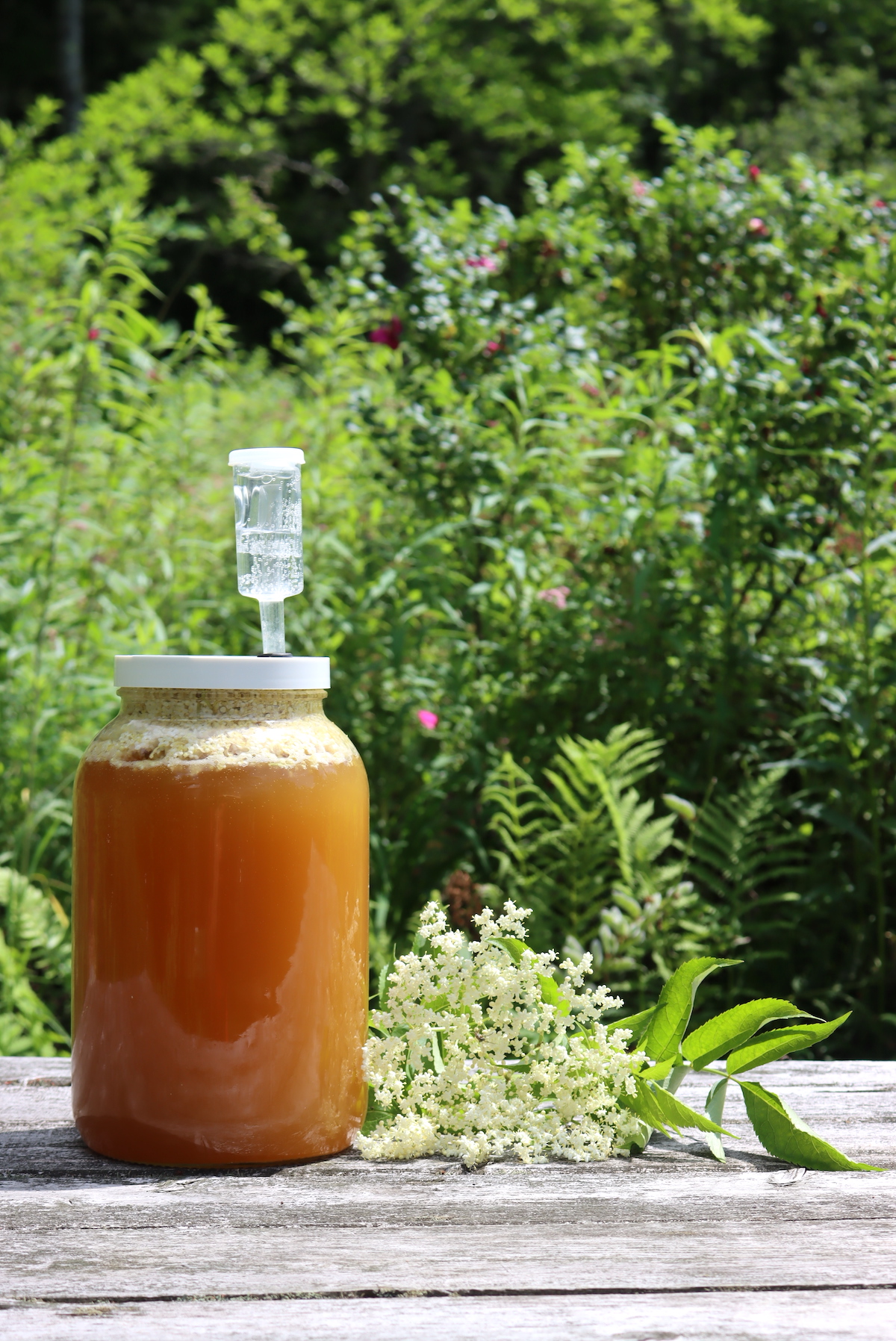
How to Make Elderflower Wine (or Mead)
Start by harvesting the elderflowers, then very carefully stripping the blossoms from the stems and greenery. A fork works well for this task, but your fingers are great too.
If you’re using dried elderflowers, they’ll already come stemmed from your herbal supplier. In that case, use about half as much (2 cups instead of 4).
A few small green stem pieces is ok, but you’ll want to remove as much as possible.
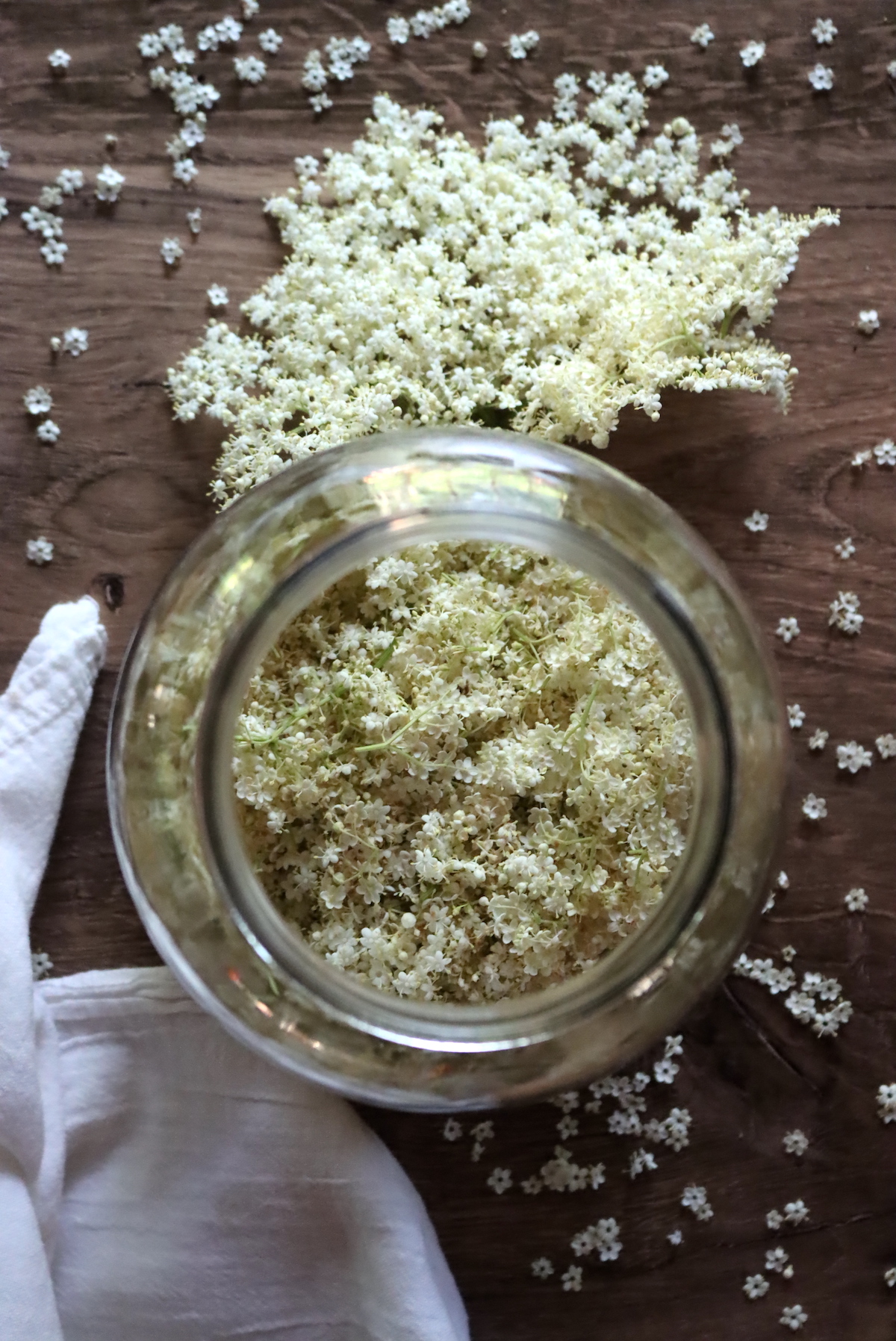
Bring about a half gallon of water to a boil on the stove, and then add the sugar or honey. Stir to dissolve.
Remove the pot from the heat and allow the sugar mixture to cool completely before proceeding.
Pour the cooled mixture over the flowers in your wide-mouth fermenter. Add the remaining ingredients, except wine yeast.
Rehydrate the packet of wine yeast in about a cup of water and allow it to “bloom” for about 10 minutes. This allows it to wake up before it goes into the concentrated sugar mixture. Without this time, yeast can shock and have trouble doing its important work.
Once you add the yeast, cap the container and seal it with a water lock (or cover with a towel for primary, as a water lock is optional until secondary).
If all goes well, the mixture should be actively bubbling in 24 to 72 hours.
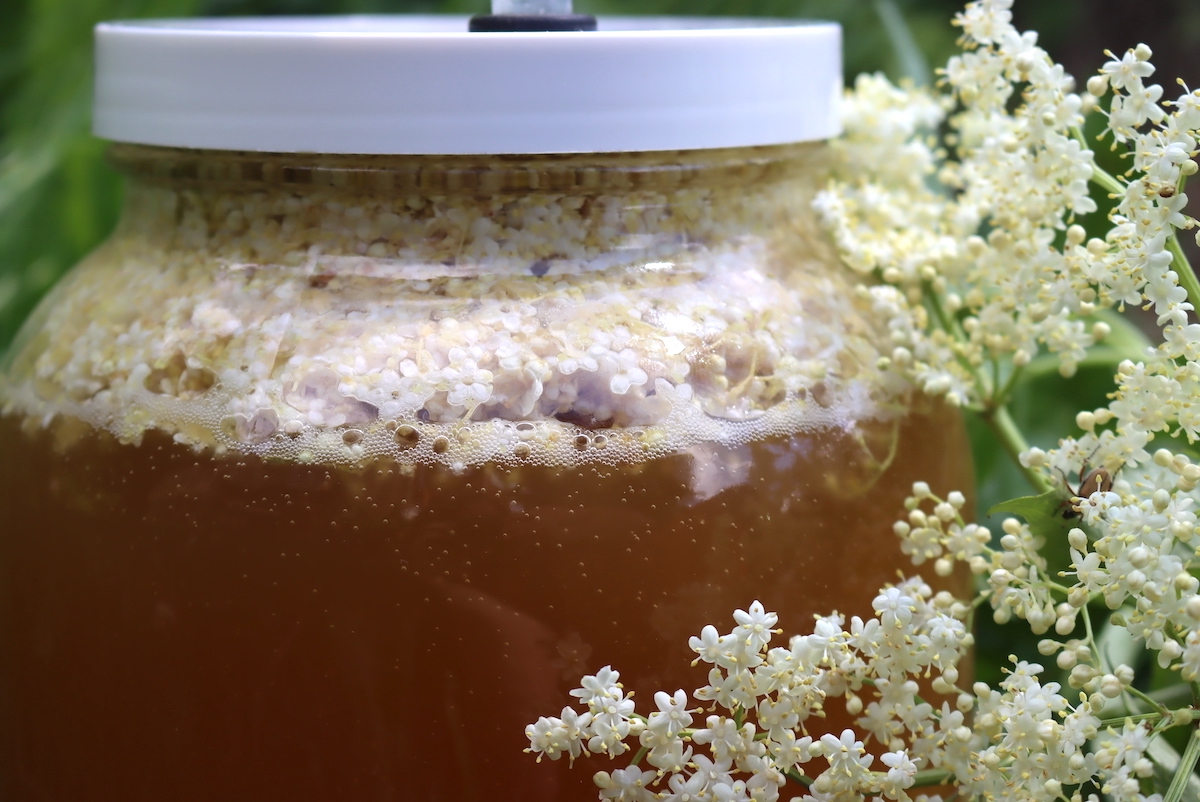
Allow the mixture to ferment with the elderflowers for 10 to 14 days. This is known as “primary fermentation,” and it’s the most active part of the fermentation process. It should be bubbling actively every day, but it’ll start to slow down at the 10 to 14-day mark.
Once primary fermentation is over, things slow down a bit, and it’s time to use a siphon to move the elderflower wine into a clean container.
The sediment at the bottom of the container, known as lees, can create off flavors if you leave the wine in the same container as the primary. It’s also time to filter out any flowers and let the finished flavors develop.
Once the wine is moved to a clean container, it’s now in “secondary fermentation,” and less alcohol is made each day. However, this is when most of the complex flavors develop, and the wine (or mead) will mellow a bit.
Secondary fermentation usually lasts 4 to 6 weeks for wine, and 4 to 6 months for mead. Make sure the wine is in a container sealed with an airlock during this time so that it doesn’t turn to vinegar.
Once secondary fermentation is complete, it’s time to bottle the wine.
Use a siphon to move the elderflower wine into wine bottles and cork with a bottle corker. Allow the wine to bottle condition for at least another two weeks (preferably another two months or more) before drinking.
Enjoy however you like, but I personally think it’s best chilled.
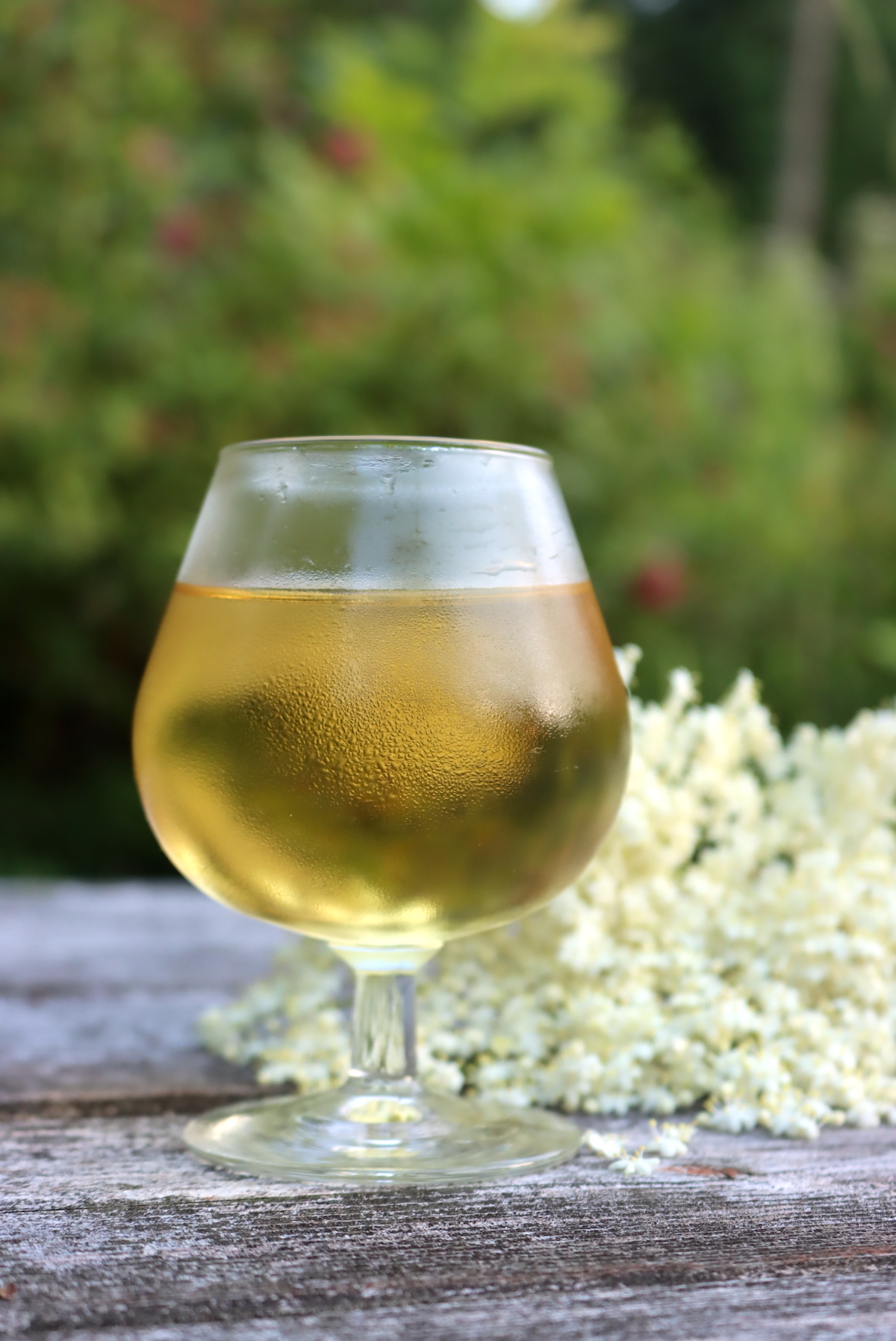
Ways to Use Elderflowers
Looking for more fun ways to use elderflowers?
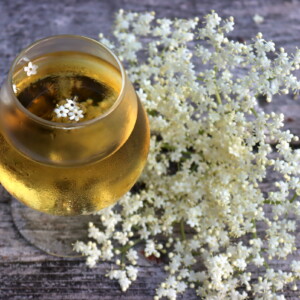
Elderflower Wine (or Mead)
Ingredients
- 1 quart stemmed elderflowers, from about 1 1/2 to 2 gallons flower sprays
- 5 to 6 cups sugar, or 3 lbs honey for mead
- 6 cups white grape juice, for wine only, skip if using honey
- 1/4 cup lemon juice
- 1 tsp yeast nutrient
- 1/4 tsp tannin powder
- 1 wine yeast
Instructions
- Decide if you're making a flower wine (using sugar) or mead (using honey). The ingredients are the same for both, with the only difference being honey used in place of sugar for mead. For wine, you can add 4 to 6 cups of white grape juice in place of some of the water to help improve the wine’s body, though this is optional. Mead naturally has a fuller body, so grape juice isn't necessary. If you do use grape juice, reduce the sugar by about 1/2 to 1 cup.
- Pour about half a gallon of water into a pot and bring it to a boil on the stove. Stir in the sugar or honey until fully dissolved. Let the mixture cool completely before moving to the next step.
- Place the elderflower petals into the primary fermenter, then pour the cooled sugar water over them.
- Add the remaining winemaking ingredients (except the yeast) and stir to combine.
- Add cool water to the fermenter to nearly fill it. Mead will require a bit more water since there's no grape juice involved. Make sure the mixture is no hotter than 90°F, ideally around room temperature.
- Once the mixture has cooled, dissolve the yeast packet in 1/4 to 1/2 cup of room-temperature water and let it rehydrate for 10 minutes. Add the yeast mixture to the fermenter. Refer to yeast recommendations in the notes.
- Fill the fermenter with water (if needed) to reach the neck, then seal it with a rubber stopper and airlock. Let the wine ferment for 10 to 14 days until the fermentation slows (primary fermentation).
- Once primary fermentation is complete, use a siphon to transfer the wine to a clean vessel, leaving the sediment behind. Remove the elderflowers at this stage and switch to a narrow-neck fermenter if you were using a wide-neck one. Re-seal with the airlock. For wine, allow it to ferment in secondary for 4 to 6 weeks. For mead, let it ferment for at least 4 months.
- When fermentation is complete, bottle your wine or mead in wine bottles. Let the wine bottle-condition for at least 2 weeks, and wait at least 2 months for mead. While flip-top Grolsch-style bottles are fine for short-term storage, wine bottles are better for long-term storage (over 2-3 months).
Notes
- Red Star Cote des Blancs (Geisenheim Epernay) ~ This yeast enhances the fruity notes and sweetness in both red and white wines. Known for its slow fermentation and low foam production, it takes a bit longer to finish but helps preserve delicate esters and complex flavors. It's a popular choice for apple wines, ciders, and sweeter whites like Chardonnay, as well as floral wines like this elderflower wine. With a lower alcohol tolerance, particularly at cooler fermentation temperatures, it tends to leave more residual sugars in the wine. Its alcohol tolerance ranges from 12-14%, and it performs best within a temperature range of 64-86°F.
- Lavin D47 ~ Adds a strong fruity, floral character to wines with spicy aromas that would add complexity to any fruit wine. Specifically adds tropical fruit and citrus notes. Only a moderately vigorous fermenter, and may start slowly. Alcohol tolerance to 15%, ideal temperature range 59 to 86 F.
- Lalvin K1-V1116 ~ A dependable fermenter that works well in difficult fermenting conditions (low/high temperatures, low nutrients, etc). It’s also known for contributing more fruity and floral esters than other types of wine yeast. It’s generally used with “uninteresting” juices that can use a bit of perking up. High alcohol tolerance, up to 18%, and an incredible temperature range from 50 to 95F.
Nutrition
Nutrition information is automatically calculated, so should only be used as an approximation.
Flower Wine Recipes
Looking for more flower wine recipes to try?
Homemade Wine Recipes
Elderflowers make a tasty wine, but they’re not the only thing you can put in a bottle this season!




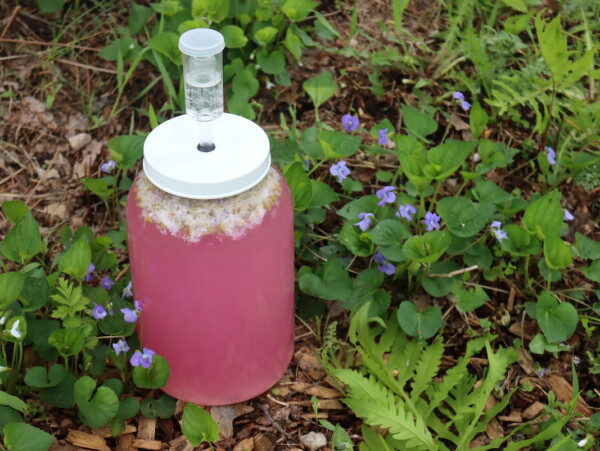










Can you use dried elderflowers for this?
Yes, this would work wonderfully with dried elderflower!
Thanks for sharing this recipe. I’d like to know why some recipes call for adding hot sugar solution to the fruit or flower? In your recipes the sugar solution is cooled before adding to the ferment material. What difference does the water temperature make to the pre-ferment material?
We prefer a cold infusion for flowers because this process helps them to retain the delicate flavors and aromas.